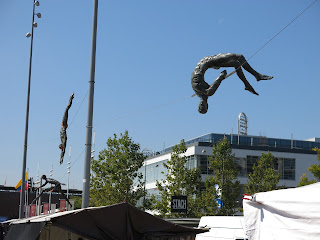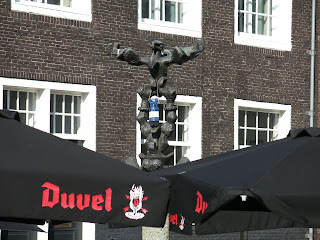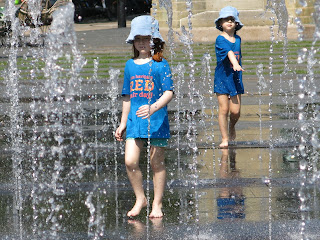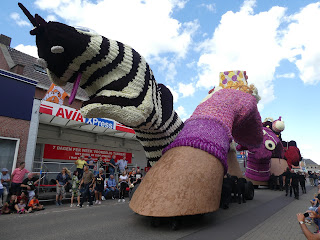We spent the last weeks of our trip in a wonderful place called
Gouderac, just outside
Gouda, in south Holland. You see, Gouderac is in place called
Krimpenerwaard, though locals call it “the meadows.” Bounded by three rivers with many dykes, this is
polder or reclaimed land which is now made up of long ribbons of land separated by narrow canals. The land is covered with grass, for the most part, and some of this is grazed upon by cows. And from these cows they get the milk to make Gouda cheese. Great cycling.
We paid our respects in Gouda, but we would be back.
Then we drove north to
Alkmaar, which is also known for its cheese market. Normally a charming town offering a wonderful alternative to Amsterdam, on market day it is a mass of tourists clogging the narrow lanes.
We walked through town to the
Stedlijk Museum where, upstairs, we found a gallery devoted to Dutch Modern artists, leading to the
Bergense School, 1919-1925.
Led by
Jan Sluijters and
Jan Toorop, and influenced by
Henri Le Fauconnier, these homegrown artists developed a style they called
Luminist. Among them, were two women who stood out:
Charley Toorop (daughter of Jan) and
Else Berg.
 |
| Zeeland Farmers by Henri Le Fauconnier, 1913 |
 |
| Hof Estate in Bergen by Else Berg, 1917. |
 |
| Self Portrait wearing a Blue Dress by Else Berg c1917 |
We continued on to neighboring
Bergen, where many more artists lived and worked together. However, there was not much to see, and the
Kranenbergh Museum had little of interest aside from the work of two women sculptors which we found outside:
Pauline Eecen and
Iris le Rütte.
 |
| De Vluchteling by Pauline Eecen |
 |
| Haas by Iris le Rütte, 2012 |
 |
| Hazentafel by Iris le Rütte, 2006 |
 |
| In Beweging by Nicole van Stralen, 1993 |
 |
| Daphne in de wind by Iris le Rütte, 2015 |
 |
| Flora by Pauline Eecen, 1955 |
It was drizzling when we drove up to
Leersum for their flower parade, or
Bloemencorso. It was very early, and we got there just as the judging began with all the floats lined up in one area. This may have been to our advantage as we, once again, had the opportunity to get up close to the floats.
All were made of Dahlias and a little other flora. Most featured animation and music as well.
The event also had an Art Market, which provided a nice diversion. But
it was raining and we had to leave before the parade got started. If it
did.
We received an invitation to the opening for the 10th Anniversary exhibition of a
Den Haag group called
Art and Jazz. Among other things, they produce the
DuneArt festival in which we participated last year. You could look out the windows of the gallery and see the
Binnehof, or Parliament building, reflecting in the
Hofvijver. Practically across the street from the Maurithuis! The invite came from
Wiebe Dekker, chairman of
Art & Jazz, and we also saw
Patty van de Ende (
End of Dull Art) whom we met last year.
 |
| Patty |
The
Gouda cheese market was lots of fun. Similar to Alkmaar but much better, with fewer tourists. There was a yellow-suit clad (the color of Gouda cheese) MC who explained how the cheese market worked, in several languages.
Amsterdam was just an hour away, so began south of the city, in
Amstelveen, home of the
CoBrA Museum. A place we cannot pass up a visit. Wonderful, as usual, they also had a special show called
Nieuwe Nuances/New Nuances:
Women artists in and around CoBrA.
 |
| Composition by Dora Tuynman, 1953 |
 |
| untitled (Love Couple) by Lotti van der Gaag. |
 |
| The Rainbow by Else Alfelt, 1952 |
 |
| untitled by Sonja Ferlov Mancoba, 1960 |
CLICK HERE FOR MORE.
Just north of Amstelveen is the residential borough called
Amsterdam-Zuid. In the northern section is the
Apololaan, a long narrow park, which is the site of
Art-Zuid, now in it’s sixth incarnation. There were more than sixty sculptures and installations along a green gallery with artists ranging from the well-known
Barry Flanagan or
Jean Dubuffet, to more contemporary artists such as
George Struikelblok and
Gloria Friedman.
 |
| Kotomisi by George Struikelblok, 2019 |
 |
| Myth (Sphynx) by Marc Quinn, 2007 |
 |
| Penetrable bleu by Jesus Rafael Soto, 2015 |
 |
| Het Kompas by Henk Visch, 2015 |
And just north of
Amsterdam-Zuid is Amsterdam's
Museumplein, so we popped up for some more Kunst.
Zwolle is about an hour and a half northeast of our place in Gouderak or an hour east of Amsterdam; a very nice town with a good Art museum, two sculpture parks, and a thriving bookstore in a former 15th century convent.
Waanders In Broeren is the name of the bookstore.
If you will forgive me, this gets a little complicated, but you can follow along. Collector Dirk Hannema convinced the government that
Kasteel Het Nijenhuis, parts of which date to 1680, should be kept from further deterioration and had it restored as a museum with his own collection as a beginning. The founder of
Museum de Fundatie occupied the Kasteel from 1958 to his death in 1984. It is now the home to more than ninety sculptures from
the collections of
Museum de Fundatie,
Museum Beelden aan Zee in
Scheveningen and the
Province of Overijssel.
 |
| Les Amants Assis by Sophi Vari, 1983 |
 |
| Red Moon by Dora Dolz, 1994 |
 |
| Mikkel by Tom Claassen, 2017 |
 |
| Horn of Plenty by Dora Dolz, 1994 |
Since 2005, the
Paleis aan de Blijmarkt, a former court building Zwolle has been home of the
Museum de Fundatie. "The Dome," designed by Dutch architecture firm Bierman Henket, was added in 2013.
 |
| The Monument by Atelier van Lieshout, 2015 |
 |
| Papillons by Francis Picabia, 1929 |
 |
| Dance IV by Lynn Chadwick, 1955 |
 |
| La Blute Fin moulin by Vincent Van Gogh, 1886 |
 |
| eclining Nude by Charlotte van Pallandt, c 1926 |
 |
| Queen Wilhemina by Charlotte van Pallandt |
Beeldenpark Anningahof opened on the Anningahof estate in 2004 featuring, apparently, all Dutch sculptors. While some artworks remain in place, there is a new show each year on these lovely grounds.
 |
| Monere by Levi van Veluw |
 |
| Kringloop by Marc de Roover |
 |
| Giants by Ewerdt Hilgemann |
 |
| Afterwar Delight by Pepijn van den Nieuwendijk |
Zwolle is also home of
Herman Brood.
And just a few more from Zwolle:
 |
| Archangel Michael by Herman Lamers |
While
Rotterdam is the largest port in all of Europe, it is just down the river from where we were staying, so we went there on Saturday for a look around. We have visited Rotterdam before, fortunately, as the main kunstmuseum,
Boijmans Van Beuningen, just closed for the next seven years. But
The Chabot, a museum dedicated to Dutch painter and sculptor
Hendrik Chabot (1894–1949), was open and there was plenty of Art to keep us happy.
 |
| in the style of New Objectivity by Gerrit Willem Baas and Van der Vlugt, and Leonard Stokla, 1938 |
 |
| Landschap by Henk Chabot, 1928 |
 |
| Vrouwenportret (Danseres) by Jan Sluijters, 1916 |
 |
| Springend Paard by Henk Chabot, 1923 |
 |
| Zelf-portret tegen muur by Charley Toorup, 1925 |
We went to our favorite place in Rotterdam: at the base of
Ossip Zadkine’s masterpiece
Destroyed City. Twenty-one feet high, it was commissioned by the people of Rotterdam in 1953 to remember how their city was flattened by the Germans during WW2. I’m sorry the picture is not better, but Zadkine really captured the emotions of a city in terror and despair.
They have a saying in Rotterdam: “Take a picture of the skyline because next time you look it will have changed.” Or something like that. The architecture is stunning; varied and surprising. A brand-new city. Not the kind of place that would have walls for street art, you might think. But in addition to the map they publish with almost fifty sculptures located, there is another with thirty-four sites for murals and the like.
A vibrant city, we loved just walking around.
 |
| Santa Claus by Paul McCarthy, 2001 |
 |
| Au mijn Benen by Henk Visch, 1996 |
 |
| Sterker door strijd by Mari Andriessen, 1957 |
 |
| Standing Figure by Willem de Kooning, 2005 |
 |
| De Vrijheid van Meningsuiting by BKOR, 2006 |
 |
| Flora by Theo Crosby |
 |
| Cascade by Atelier van Lieshout, 2009 |
Desiderius Erasmus by Hendrick de Keyser, 1618 reproduced by 3D printer in 2017.
As is was Saturday we came across a couple of bachelorette parties. Did I ever tell you that in France they are called: “Enterrement de vie de jeune fille,” or “the burial of the life of a young girl.” In Dutch it’s: “Vrijgezellenfeest” but I'm still looking for a literal translation.
Zundert is Vincent’s birthplace, but the only thing that invokes his spirit is a statue of Vincent and brother Theo done by Ossip Zadkine in 1964. On the base, which was of stone from Saint Remy, the inscription from the last letter from Vincent to Theo reads: “Through my deeds you have witnessed the creation of several paintings which will breathe tranquility even in times of upheaval.”
 |
| Vincent and Theo by Ossip Zadkine, 1964 |
But that’s not the reason we went there this time. It was time for another bloemencorso. This time, the “biggest in the World”*. All encrusted with Dahlia blooms, there were twenty enormous floats representing area hamlets competing for prizes. The bands came from all over, and they have been doing this for over eighty years.
As you can imagine, choosing photos was difficult, but here are a few. Oh, I should also point out that all the floats are human powered.
*While they claim to be the biggest, the Rose Parade has forty-five floats, Even the Daffodil Parade in Puyallup, WA is eighty-six years old and features 140 entries. I was there once and it was spectacular.
And so, our holiday comes to an end. I hope you enjoyed it. We certainly did.


































































































































No comments:
Post a Comment